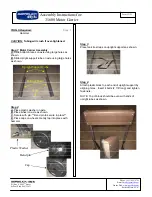
Target Speed PPS
Start Speed PPS
Total Number Of Steps
Steps to Stop
Target Speed PPS
Start Speed PPS
Total Number Of Steps
Steps to Stop
Target Speed PPS
Start Speed PPS
Total Number Of Steps
Steps to Stop
Motor Reaches Stop Speed at the Stop Speed
Stop Speed PPS
Stop Speed PPS
Motor Reaches Stop Speed before the Stop Speed is reached
Motor runs out of Steps before reaching Stop Speed
The Windows Application
23
SLVU701B – March 2012 – Revised July 2019
Copyright © 2012–2019, Texas Instruments Incorporated
DRV8834 Evaluation Module
When a deceleration profile is issued, the controller decreases the speed until reaching the stop speed
value. If the number of steps parameter is met before the deceleration profile is complete, then the motor
stops at the current speed. If the stop speed is met before all the number of steps are issued, then the
motor rotates at the stop speed value until all the steps are executed.
Ideally, the system must be tuned to resemble as much the case in which the controller executes all the
commanded steps at a speed as close as possible to the stop speed. In the event this is not possible, due
to the particular parameters being chosen, stopping the motor at a speed very close to the stop speed is
often good enough to ensure good motion quality and application performance.
Figure 30. Move Steps
4.8.1
Microstepping Resolution
Segmenting a full step into microsteps can be achieved by how many times we can divide the current
regulation magnitude. The DRV8834 device offers the flexibility of using either internal indexing with up to
32 degrees of microstepping for the simplest implementation, or infinite degrees of microstepping when
using the an external reference voltage source.
The Microstepping Resolution drop down box gives the user the option to change the full step divider
factor so that microsteps from half step to 512 degrees of microstepping are obtained, depending on the
chosen operating mode.






































